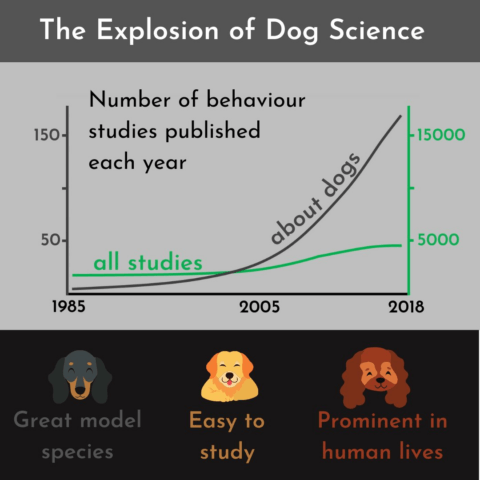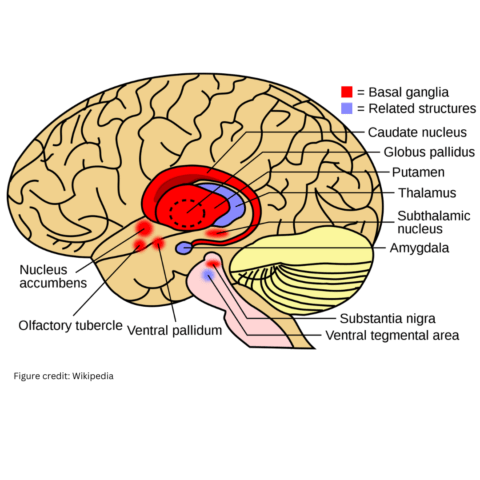
Over the last two decades the number of studies on domestic dogs have exploded. This surge in research has allowed us to gain a deeper understanding of our closest animal companions, shedding light on various aspects of their behaviour, cognition, and health. Key findings from this research have emphasised the remarkable intelligence and emotional complexity of dogs, highlighting their ability to form deep bonds with humans and other animals. Such research have demonstrated that dogs possess a unique understanding of human gestures and facial expressions, enabling them to communicate effectively with humans, as well as significant benefits of the human-dog bond, with interactions with dogs leading to reduced stress levels, increased oxytocin levels (the “love hormone”), and improved overall well-being. Thanks to the improvement in dog-related research, we have also advanced our knowledge of dog genetics, and the impact different handling and training techniques can have on dogs, attachment and much more.
Some of this research has included looking at how dogs love, thanks to neuroscientist Dr Gregory Berns, who has used MRI technology to delve into the canine mind, revealing fascinating insights.
In 2012, Dr. Berns embarked on a project to understand what dogs think, specifically about humans. He used MRI machines to explore the canine mind, training dogs to stay still in the machine and respond to specific signals. This allowed researchers to observe their brain activity in response to different stimuli.

One of the key findings of Dr Berns’ research was the activation of the caudate nucleus in dogs’ brains when they smelled their human’s scent or responded to a hand signal for a treat. This part of the brain is rich in dopamine receptors, linking reward and motivation with action. In humans and other animals, activation in this area signifies that something important has happened, requiring a response.
The caudate nucleus is part of the basal ganglia, a group of nuclei located deep within the brain, and is involved in various functions, including motor control, learning, and emotions. And the caudate nucleus is particularly important for understanding the concept of reward and reinforcement in dogs. For example, when a dog experiences something pleasurable or rewarding, such as receiving a food treat or playing with their favourite toy, the caudate nucleus is activated. This activation leads to the release of dopamine from the substantia nigra and the ventral tegmental area.
When Dr Berns and his team were monitoring dogs trained to lay still in Functional MRI (fMR) scanners, the activation of the caudate nucleus was not just a response to food but a symbolic representation of something they had learned to associate with pleasure. This was a significant discovery, it showed that dogs have the ability to understand and respond to symbolic cues, not just instinctive reactions. The researchers used the scans to compare the dogs’ brain response to different hand signals, for example, one representing a reward (hot dog) and another representing no reward. The scans revealed that the reward system in the dogs’ brains was activated by the hand signal that meant a hot dog, not the hot dog itself.
Interestingly, the same part of the brain activated when dogs smelled a familiar human, even if the human was not present. This suggests that dogs have representations of us that persist when we’re not there, which means they do indeed miss us when we’re gone.

Dr Berns’ research also explored whether it mattered who gave the hand signals to the dogs. Contrary to what scientists like Ivan Pavlov might suggest, the results indicated that the relationship between the dog and the person giving the signal DID matter. The dogs’ brains responded differently to signals from their owners compared to strangers or computers – this emphasised the unique bond between dogs and their human companions.
Key take-aways
The love between a dog and their human isn’t just a sentimental notion, it is real and deep-rooted. Thanks to the plethora of research that has focused on our four-legged friends over recent years, including ground-breaking research from Dr Gregory Berns using MRI technology, this has opened a new window into understanding how dogs love. And serves as a reminder that our connection with man’s best friend is not only emotional but also biologically rooted.
So next time your dog greets you with a full body wiggle and loving lick, remember that these are not just instinctive reactions. They are genuine expressions of love, as real and profound as any human emotion, and are grounded in the same neurotransmitters that govern our own feelings of love and attachment.
Reference:
“How dogs love us | Dr. Gregory Berns | TEDxAtlanta.” YouTube, uploaded by TEDx Talks, 18 May 2015, link.
Learn more about our classes

Get Hanne's book, clothing and more
Hanne has a number of publications including her book Playing With Your Dog to help owners work out the games that are best suited for their pet to play throughout his life, from puppyhood to old age, available from Amazon. Check out Hanne's range of contemporary casuals The Collection – for pet lovers made from recyclable, organic materials that are sustainably sourced.

